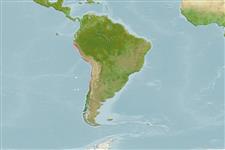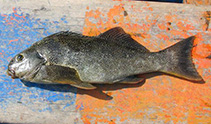Add your observation in Fish Watcher
| Native range | All suitable habitat | Point map | Year 2050 |

|
| This map was computer-generated and has not yet been reviewed. |
| Aplodactylus punctatus AquaMaps Data sources: GBIF OBIS |
Upload your photos and videos
Pictures | Google imageAplodactylus punctatus
Picture by Eakins, R.
Pictures | Google imageAplodactylus punctatus
Picture by Eakins, R.
Chile country information
Common names:
Chuquisa, Jerguilla, Pintadilla
Occurrence: native
Salinity: marine
Abundance: abundant (always seen in some numbers) | Ref: Russell, B.C., 2000
Importance: | Ref:
Aquaculture: | Ref:
Regulations: | Ref:
Uses: no uses
Comments: Type locality, Valparaiso, MNHN A.2995 (holotype of Aplodactylus punctatus, 23.9 cm SL); MNHN A.2996 (holotype of Aplodactylus vermiculatus, 14.3 cm SL); MNHN A.2997 (holotype of Aplodactylus guttatus, 6.9 cm SL); MNHN A.2999 (holotype of Aplodactylus regina, 27.3 cm SL) (Ref. 86913). Reported from near Viña del Mar; also from Golfo de Arauco (Ref. 5530).
National Checklist:
Country Information: https://www.cia.gov/library/publications/resources/the-world-factbook/geos/ci.html
National Fisheries Authority:
Occurrences: Occurrences Point map
Main Ref: Stepien, C.A., 1990
National Database:
Occurrence: native
Salinity: marine
Abundance: abundant (always seen in some numbers) | Ref: Russell, B.C., 2000
Importance: | Ref:
Aquaculture: | Ref:
Regulations: | Ref:
Uses: no uses
Comments: Type locality, Valparaiso, MNHN A.2995 (holotype of Aplodactylus punctatus, 23.9 cm SL); MNHN A.2996 (holotype of Aplodactylus vermiculatus, 14.3 cm SL); MNHN A.2997 (holotype of Aplodactylus guttatus, 6.9 cm SL); MNHN A.2999 (holotype of Aplodactylus regina, 27.3 cm SL) (Ref. 86913). Reported from near Viña del Mar; also from Golfo de Arauco (Ref. 5530).
National Checklist:
Country Information: https://www.cia.gov/library/publications/resources/the-world-factbook/geos/ci.html
National Fisheries Authority:
Occurrences: Occurrences Point map
Main Ref: Stepien, C.A., 1990
National Database:
Common names from other countries
Classification / Names Common names | Synonyms | Catalog of Fishes(genus, species) | ITIS | CoL | WoRMS | Cloffa
Teleostei (teleosts) > Centrarchiformes (Basses) > Aplodactylidae (Marblefishes)
Etymology: Aplodactylus: Greek, aploe, -es = simplicity + Greek, daktylos = finger (Ref. 45335).
More on author: Valenciennes.
Etymology: Aplodactylus: Greek, aploe, -es = simplicity + Greek, daktylos = finger (Ref. 45335).
More on author: Valenciennes.
Environment: milieu / climate zone / depth range / distribution range Ecology
Marine; demersal. Tropical; 5°S - 37°S, 82°W - 70°W
Distribution Countries | FAO areas | Ecosystems | Occurrences | Point map | Introductions | Faunafri
Southeast Pacific: reported from the warm temperate waters of the west coast of South America; from Callao, Peru (12° 02'S) to Talcahuano, Chile (36°41'S).
Size / Weight / Age
Maturity: Lm ? range ? - ? cm
Max length : 43.7 cm TL male/unsexed; (Ref. 95867); max. published weight: 862.00 g (Ref. 53696)
Max length : 43.7 cm TL male/unsexed; (Ref. 95867); max. published weight: 862.00 g (Ref. 53696)
Short description Identification keys | Morphology | Morphometrics
Dorsal spines (total): 16 - 17; Dorsal soft rays (total): 18 - 21; Anal spines: 3; Anal soft rays: 6 - 9; Vertebrae: 34 - 35.
This species is most abundant littoral species on the coast of central Chile, found in close association with the brown kelp Lessonia trabeculata. Juveniles found in tidepools to a maximum size of 15.7 cm TL and an estimated 3 years of age, adults occur subtidally. It is mainly herbivorous, feeding almost exclusively on brown, red and green algae, with a strong preference for green and red algae (digestion by acid hydrolysis). Its meat reported as an excellent pan-fish, with rich, white, sweet, and flaky meat (Ref. 86913).
Life cycle and mating behavior Maturity | Reproduction | Spawning | Eggs | Fecundity | Larvae
Main reference
Upload your references | References | Coordinator : Russell, Barry | Collaborators
Russell, B.C., 2000. Review of the southern temperate fish family Aplodactylidae (Pisces: Perciformes). J. Nat. Hist. 34(1):2157-2171. (Ref. 86913)
Threat to humans
Harmless
Human uses
Fisheries: of no interest
FAO(Publication : search) | FishSource | Sea Around Us
More information
Population dynamics
Growth parameters
Max. ages / sizes
Length-weight rel.
Length-length rel.
Length-frequencies
Mass conversion
Recruitment
Abundance
Growth parameters
Max. ages / sizes
Length-weight rel.
Length-length rel.
Length-frequencies
Mass conversion
Recruitment
Abundance
Life cycle
Reproduction
Maturity
Fecundity
Spawning
Spawning aggregations
Eggs
Egg development
Larvae
Larval dynamics
Reproduction
Maturity
Fecundity
Spawning
Spawning aggregations
Eggs
Egg development
Larvae
Larval dynamics
Anatomy
Gill area
Brain
Otolith
Gill area
Brain
Otolith
Physiology
Body composition
Nutrients
Oxygen consumption
Swimming type
Swimming speed
Visual pigments
Fish sound
Diseases & Parasites
Toxicity (LC50s)
Body composition
Nutrients
Oxygen consumption
Swimming type
Swimming speed
Visual pigments
Fish sound
Diseases & Parasites
Toxicity (LC50s)
Genetics
Genetics
Heterozygosity
Heritability
Genetics
Heterozygosity
Heritability
Human related
Aquaculture systems
Aquaculture profiles
Strains
Ciguatera cases
Stamps, coins, misc.
Aquaculture systems
Aquaculture profiles
Strains
Ciguatera cases
Stamps, coins, misc.
Tools
E-book | Field guide | Length-frequency wizard | Life-history tool | Point map | Classification Tree
| Catch-MSY |
Special reports
Download XML
Internet sources
Aquatic Commons | BHL | Cloffa | Websites from users | Check FishWatcher | CISTI | Catalog of Fishes(genus, species) | DiscoverLife | ECOTOX | Faunafri | Fishtrace | GenBank(genome, nucleotide) | GloBI | GOBASE | | Google Books | Google Scholar | Google | IGFA World Record | MitoFish | Otolith Atlas of Taiwan Fishes | PubMed | Reef Life Survey | Scirus | SeaLifeBase | Tree of Life | Wikipedia(Go, Search) | World Records Freshwater Fishing | Zoobank | Zoological Record
Estimates based on models
Preferred temperature (Ref. 115969): 12.8 - 23.7, mean 19.5 (based on 165 cells).
Phylogenetic diversity index (Ref. 82804): PD50 = 0.5625 [Uniqueness, from 0.5 = low to 2.0 = high].
Bayesian length-weight: a=0.00603 (0.00284 - 0.01280), b=3.14 (2.94 - 3.34), in cm Total Length, based on LWR estimates for this species & (Sub)family-body (Ref. 93245).
Trophic level (Ref. 69278): 2.0 ±0.0 se; based on diet studies.
Fishing Vulnerability (Ref. 59153): Low to moderate vulnerability (34 of 100).




